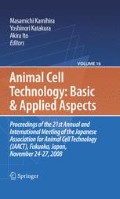Abstract
Serum withdrawal from the culture medium was reported to retard the cell growth and induce apoptosis. Recently, it was demonstrated that serum withdrawal caused an elevation in cellular ROS levels, and induced apoptosis cell death in human U397 cells. ROS such as\(\mathop {\rm{O}}\nolimits_{\rm{2}}^{ \bullet - } \) and H2O2 are important mediators of intracellular signaling pathway. Phosphatidylcholine (PtdCho) is an important phospholipid of eukaryotic cell membrane; it also plays an important role in signal transduction. It is synthesized via the cytidine diphosphocholine (CDP-choline) pathway, and the PtdCho deficiency due to the inhibition of this pathway is one of the factors that triggers apoptosis in many cell lines. The presence of exogenous H2O2 was reported to strongly inhibit the PtdCho synthesis and thus caused apoptosis in a human microglial cell line. Hence, there may be a possible link between the serum withdrawal and PtdCho synthesis and transduction pathway. Thus, in this study, the effect of PtdCho supplementation on the apoptotic cell death induced by the serum withdrawal was investigated. In the present study, 100 μg/ml of PtdCho was supplemented to the hybridoma culture in the presence of serum and under serum withdrawal conditions. Under the serum withdrawal condition, the culture supplemented with PtdCho was able to maintain about 30% viability for over 6 days, while the viability of the culture without PtdCho supplementation has decreased to about 10%. In the serum supplemented culture, the presence of exogenous PtdCho was able to enhance the survivability of hybridoma at the death phase of the culture. The viability of the PtdCho culture was maintained at about 35% for over 8 days, while the viability of the control culture has dropped to about 2%. The majority of the dead cells in the control culture were identified as apoptotic cells. No effect on the specific growth rate, maximum cell density and monoclonal antibody productivity were observed in the culture supplemented with PtdCho. The results of the present study showed that PtdCho is able to protect the hybridoma cells from apoptosis triggered by serum withdrawal.
Access this chapter
Tax calculation will be finalised at checkout
Purchases are for personal use only
References
Anthony, M.L., Zhao, M., and Brindle, K.M. (1999) Inhibition of phosphatidylcholine biosynthesis following induction of apoptosis in HL-60 cells. J. Biol. Chem. 274: 19686–19692.
Fujita, T., Terada, S., Ueda, H., and Suzuki, E. (1996) Over-expression of Bcl-2 improved survival of COS-1 cells and enhanced transient protein production. J. Ferment. Bioeng. 82 : 589–591.
Lee, S.B., Cho, E.S., Yang, H.S., Kim, H., and Um, H-D. (2005) Serum withdrawal kills U937 cells by inducing a positive mutual interaction between reactive oxygen species and phosphoinositide 3-kinase. Cell. Signal. 17: 197–204.
Moore, A., Donahue, C.J., Hooley, J., Stocks, D.L., Bauer, K.D., and Mather, J.P. (1995) Apoptosis in CHO cell batch cultures – examination by flow cytometry. Cytotechnol. 17: 1–11.
Singh, R.P., Al-Rubeai, M., Gregory, C.D., and Emery, A.N. (1994) Cell-death in bioreactors – a role for apoptosis. Biotechnol. Bioeng. 44: 720–726.
Tey, B.T., Singh, R.P., and Al-Rubeai, M. (2001) Programmed cell death – An overview of apoptosis in cell culture. Asia Pac. J. Mol. Biol. Biotechnol. 9: 1–28.
Tey, B.T., Singh, R.P., Piredda, L., Piacentini, M., and Al-Rubeai, M. (2000a) Bcl-2 mediated suppression of apoptosis in myeloma NS0 cultures. J. Biotechnol. 79: 147–159.
Tey, B.T., Singh, R.P., Piredda, L., Piacentini, M., and Al-Rubeai, M. (2000b) Influence of Bcl-2 on cell death during cultivation of a Chinese hamster ovary cell line expressing a chimeric antibody. Biotechnol. Bioeng. 68: 31–43.
Zanghi, J.A., Fussenegger, M., and Bailey, J.E. (1999) Serum protects protein-free competent Chinese hamster ovary cells against apoptosis induced by nutrient deprivation in batch culture. Biotechnol. Bioeng. 64: 108–119.
Zweigner, J., Jackowski, S., Smith, S.H., van der Merwe, M., Weber, J.R., and Tuomanen, E.I. (2004) Bacterial inhibition of phosphatidylcholine synthesis triggers apoptosis in the brain. J. Exp. Med. 200: 99–106.
Acknowledgements
This study was supported by the e-Science Fund (02-01-04-SF0763) from the Ministry of Science, Technology and Innovation; FRGS Grant (FRGS A-408) from the Ministry of Higher Education of Malaysia; and Japan Society for the Promotion of Science (JSPS).
Author information
Authors and Affiliations
Corresponding author
Editor information
Editors and Affiliations
Rights and permissions
Copyright information
© 2010 Springer Science+Business Media B.V.
About this paper
Cite this paper
Tey, B.T., Choon Yap, K., Yamaji, H., Ali, A.M., Tan, W.S. (2010). Supplementation of Phosphatidylcholine Protects the Hybridoma Cells from Apoptosis Induced by Serum Withdrawal. In: Kamihira, M., Katakura, Y., Ito, A. (eds) Animal Cell Technology: Basic & Applied Aspects. Animal Cell Technology: Basic & Applied Aspects, vol 16. Springer, Dordrecht. https://doi.org/10.1007/978-90-481-3892-0_12
Download citation
DOI: https://doi.org/10.1007/978-90-481-3892-0_12
Published:
Publisher Name: Springer, Dordrecht
Print ISBN: 978-90-481-3891-3
Online ISBN: 978-90-481-3892-0
eBook Packages: Biomedical and Life SciencesBiomedical and Life Sciences (R0)

